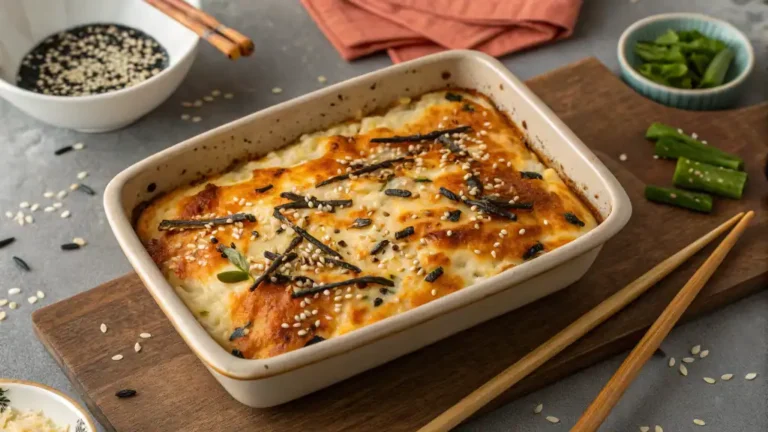How to Make Spam Musubi: A Simple Step-by-Step Guide
Learn how to make Spam musubi, the popular Hawaiian snack featuring rice, nori seaweed, and a sweet-savory glazed Spam topping.
JUMP TO RECIPE
What is Spam Musubi?
Spam Musubi is a popular handheld snack that brings together the flavors of Hawaiian and Japanese cuisine. This simple dish features marinated Spam on rice, wrapped with nori, making it easy to enjoy at any time. Originating during World War II, it combines canned meat with local ingredients, creating a comforting and tasty meal that has become a staple in Hawaiian culture.
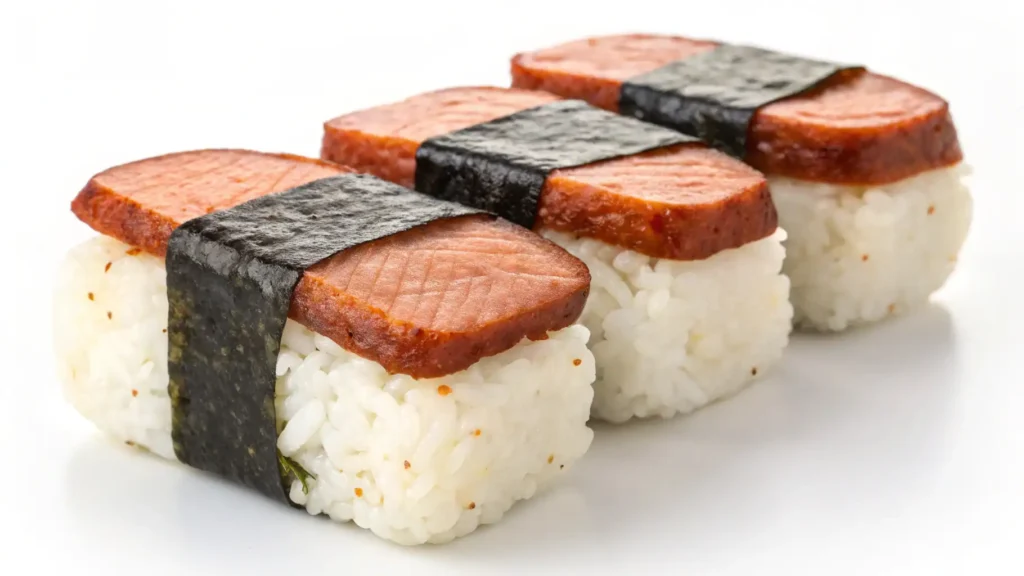
I will walk you through the steps to make your own Spam musubi at home. I’ll cover everything from gathering ingredients to cooking techniques, ensuring you have all the tips you need for the perfect ratio of rice and Spam. You’ll also discover some creative variations to try out, making this dish enjoyable for everyone.
Whether you’re a fan of Spam or just curious about making this unique snack, I invite you to join me. With some simple ingredients and a little time, you’ll have a delicious treat that pays homage to its rich history while satisfying your taste buds.
Key Takeaways
- Gather essential ingredients like rice, Spam, and nori for the recipe.
- Follow steps to cook and season Spam, ensuring great flavor.
- Explore variations to customize your Spam musubi for any occasion.
Ingredients for Spam Musubi
To make Spam musubi, I focus on selecting the right rice, choosing the best Spam, and gathering nori and other flavorings. Each ingredient plays a crucial role in creating the perfect musubi.
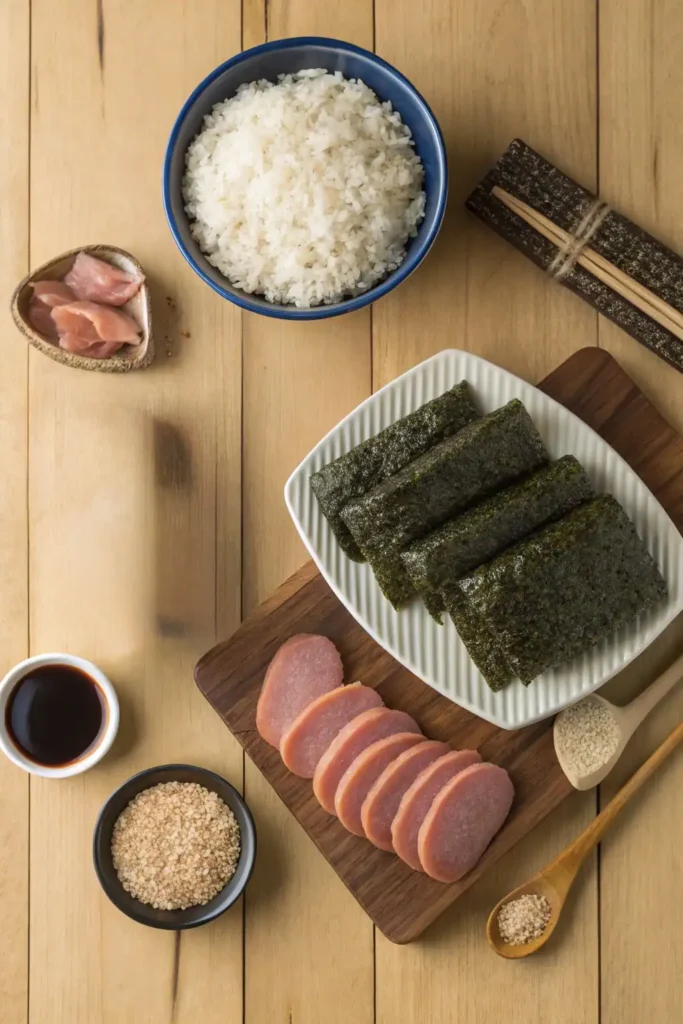
Selecting the Right Rice
For Spam musubi, I always choose short-grain rice, specifically sushi rice, due to its sticky texture. This type of rice helps hold the ingredients together, making it easier to shape the musubi. Brands like Calrose rice are popular for their consistent quality.
I rinse the rice several times until the water runs clear. This removes excess starch and ensures the rice cooks properly. After rinsing, I cook it according to package instructions, often adding a bit of rice vinegar, sugar, and salt to enhance flavor. This mixture adds a mild sweetness that complements the savory Spam.
Spam: The Star of Musubi
Spam is the key ingredient in this dish. I prefer Classic Spam, but low-sodium or flavored varieties can work as well. I slice the Spam into about 6 pieces. This ensures a good balance between Spam and rice for each musubi.
To bring out the best flavor, I fry the slices until they are golden brown. This step adds a nice texture and enhances the savory taste. For a more robust flavor, I sometimes marinate the Spam in a mixture of soy sauce, mirin, and dark brown sugar before frying. This creates an irresistible umami flavor.
Nori and Additional Flavorings
Nori sheets are essential for wrapping the musubi. I use roasted nori, which is available in most grocery stores. It’s easy to find and adds a unique taste to the dish.
Additional flavorings can elevate the musubi experience. I often sprinkle furikake, a seasoning blend of seaweed, sesame seeds, and other spices, over the rice before adding the Spam. Sometimes, I include a light drizzle of oyster sauce or soy sauce for extra flavor. You can also create variations by adding scrambled eggs or different vegetables to your musubi. Each element contributes to a well-rounded dish.
Need an appetizer? Try Crab Rangoon alongside your Spam Musubi for a delicious combo.
How to Make Spam Musubi
Once you have arranged all the ingredients, you can proceed to making spam musubi. I am listing down step wise instructions below
Step 1: Preparing the Rice
To make great Spam musubi, using the right rice is essential. I focus on cooking sticky rice, which helps the musubi hold together well. A vinegar mixture can also enhance the flavor of the rice, making each bite delicious.
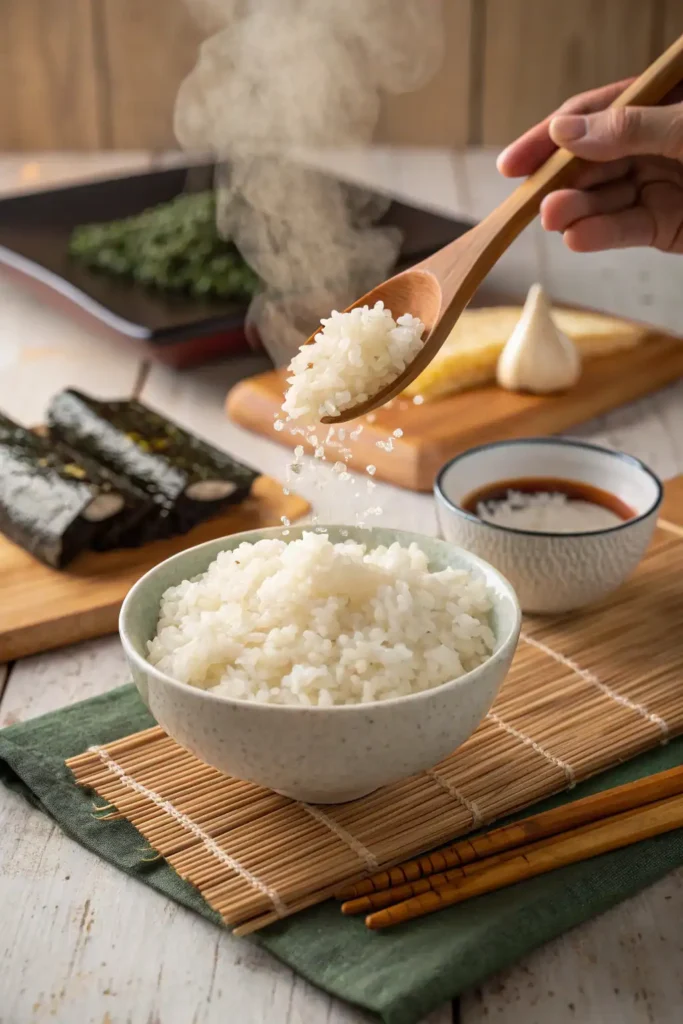
Cooking Sticky Rice
For the best results, I use short-grain sticky rice, often referred to as Calrose rice or Botan Calrose rice. This type of rice is known for its excellent stickiness, making it ideal for musubi. I typically start by rinsing the rice under cold water until the water runs clear. This step removes excess starch, which helps achieve a better texture.
Next, I cook the rice using a rice cooker for convenience. I generally 1:1.25 cups of rice to water ratio. Once cooked, I let the rice sit for about 10 minutes to steam. If I prefer a firmer texture, I can leave it longer. Avoid compacting the rice too much when transferring it to the mold. This ensures the rice remains fluffy and light.
Vinegar Mixture
To make the rice even more flavorful, I prepare a vinegar mixture. For this, I combine 2 tablespoons of rice vinegar, 1 tablespoon of granulated sugar, and a pinch of salt. I heat this mixture gently until the sugar dissolves.
Once the rice is ready, I gently fold the vinegar mixture into it. This step adds a nice tang and sweetness to the rice, enhancing the overall taste of the Spam musubi. I take care not to mash the rice while mixing, as I want to maintain its fluffy texture. By focusing on these details, I ensure my Spam musubi stands out.
Step 2: Cooking and Seasoning Spam
To create delicious Spam musubi, I need to focus on the proper preparation and seasoning of the Spam. This enhances its flavor and complements the other ingredients in the dish. Here’s how I cook and season Spam to achieve the perfect balance.
Slicing and Frying Spam
First, I open a can of Spam and carefully slice it into even rectangles. Each slice should be about 1/4 inch thick. This thickness helps the Spam crisp up while frying.

Next, I heat a skillet over medium heat and add a small amount of oil. Once the oil is hot, I place the Spam slices in the skillet. It’s important not to overcrowd the pan, so I may need to fry in batches.
I sear the Spam for about 2 to 3 minutes on each side until they become golden brown. The crispiness adds texture to the musubi. After frying, I remove the Spam and let it rest on a paper towel to absorb excess oil.
Creating the Teriyaki Glaze
To give the Spam a rich flavor, I create a quick teriyaki glaze. In a small bowl, I mix 2 tablespoons of soy sauce, 1 tablespoon of sugar, and 2 tablespoons of teriyaki sauce.
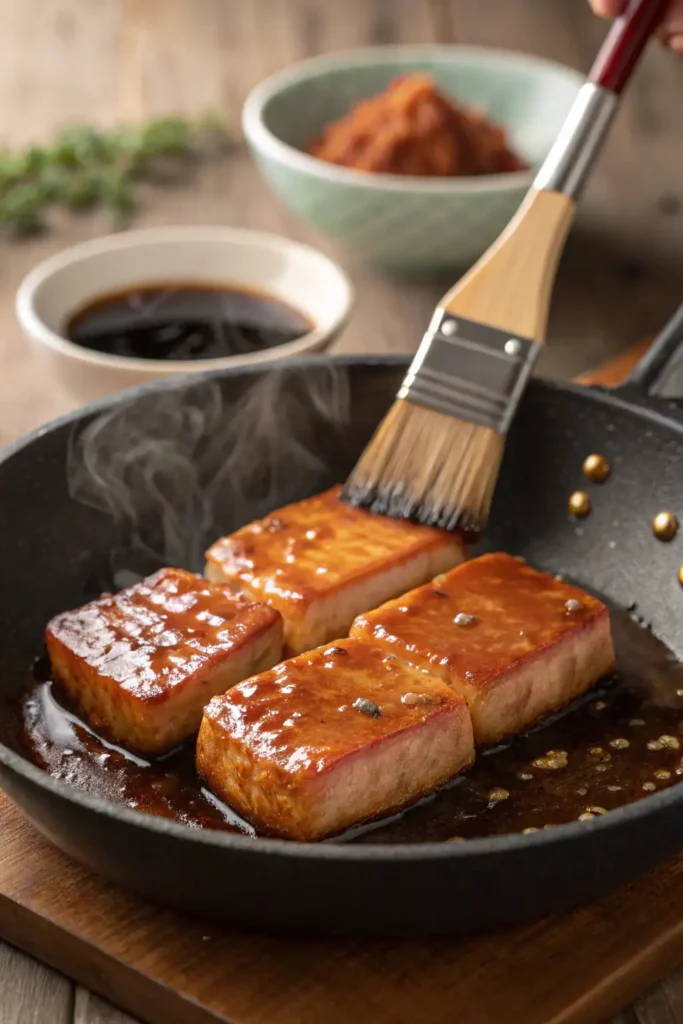
I then pour this mixture into the skillet over medium heat. The leftover oil and bits from the Spam enhance the flavor. I let it simmer for a few minutes until the sauce thickens slightly.
Once thickened, I return the fried Spam to the skillet. I coat each piece well with the glaze, making sure every slice is flavorful. After a minute, I remove the Spam from the heat. This step adds a sweet and savory finish to my Spam musubi. Pair your Spam Musubi with a comforting hot pot for an unforgettable dining experience. Pair this Hawaiian favorite with a comforting bowl of Miso Soup for a quick and delicious meal.
Step 3: Assembling Spam Musubi
Assembling Spam musubi is a fun and essential part of the process. It involves shaping the rice, layering on the Spam, and wrapping everything with nori. Each step is important for creating a delicious and visually appealing dish.
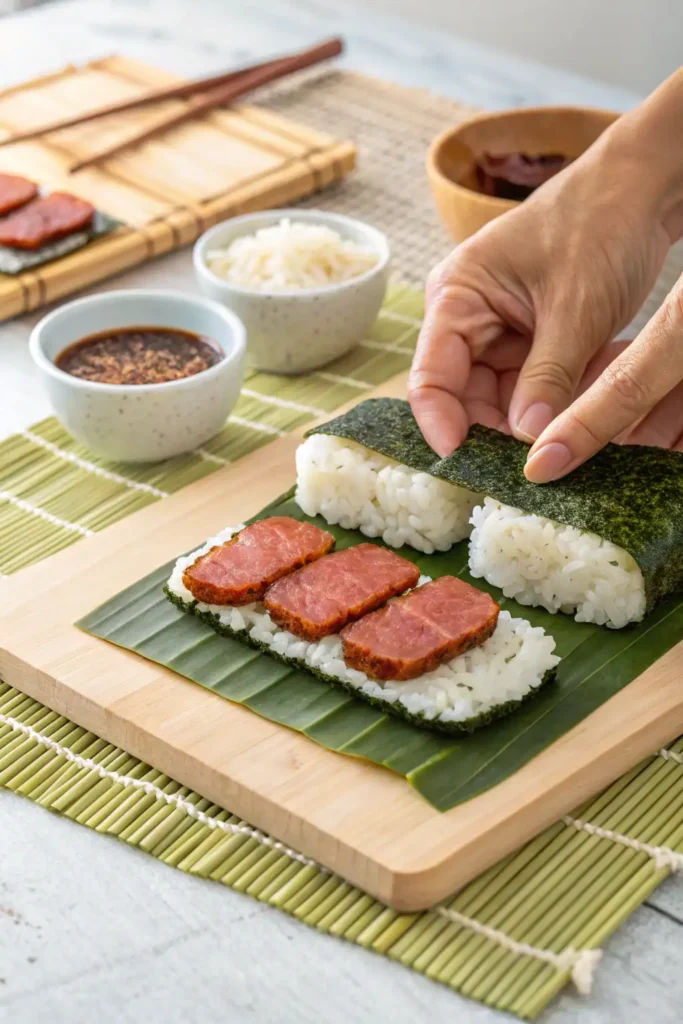
Shaping the Rice Base
First, I start with cooked rice. It’s best to use short-grain rice as it sticks together well. I wet my hands to prevent the rice from sticking to them. Then, I grab a handful of rice and shape it using my fingers.
I aim for a rectangular form that matches the size of the Spam slice. If I have a Spam musubi mold, I place some rice in it and press down firmly. This ensures that the rice holds its shape. I press it down to make a compact rice ball. It’s important that the rice is tightly packed for easy handling later.
Layering Spam and Rice
Next, I prepare the Spam. I cook it until it’s brown and crispy, which adds flavor and texture. I often marinate the Spam in teriyaki sauce for extra taste. Once the Spam is ready, I slice it into six pieces if I haven’t done so already.
I take one slice of Spam and place it on top of the shaped rice. This is crucial because it creates a balance of flavors. I can add a second layer of rice on top of the Spam if I prefer a thicker bite. If I’m using a mold, I can press more rice on top to create a firm structure.
Wrapping with Nori
The final step is wrapping the Spam musubi in nori. I take a fresh sheet of nori seaweed, which I cut into rectangular pieces, fitting the size of the musubi.
I lay the nori shiny side down on a flat surface. I then invert the rice and Spam combination onto the nori. After that, I fold the nori around the musubi tightly. I make sure to seal the ends so that the filling doesn’t fall out. If I want a crispy touch, I often toast the nori slightly before wrapping. This enhances the flavor and crunch. For your main course, our Marry Me Chicken Pasta offers rich and creamy flavors everyone will love.
Creative Variations and Serving
There are many ways to make Spam musubi unique and delicious. By adding different toppings and flavors, I can enhance the taste. Presentation and proper storage are also key to enjoying this dish later.
Adding Toppings and Flavors
To elevate my Spam musubi, I often experiment with various toppings and flavors. Furikake seasoning is a popular choice. This Japanese rice seasoning adds a savory crunch. I sprinkle it on top of the rice before adding the Spam.
Adding kimchi brings a spicy kick. I place a small amount inside the musubi with the Spam for extra flavor. Another option is avocado slices. They add creaminess and balance the saltiness of the Spam.
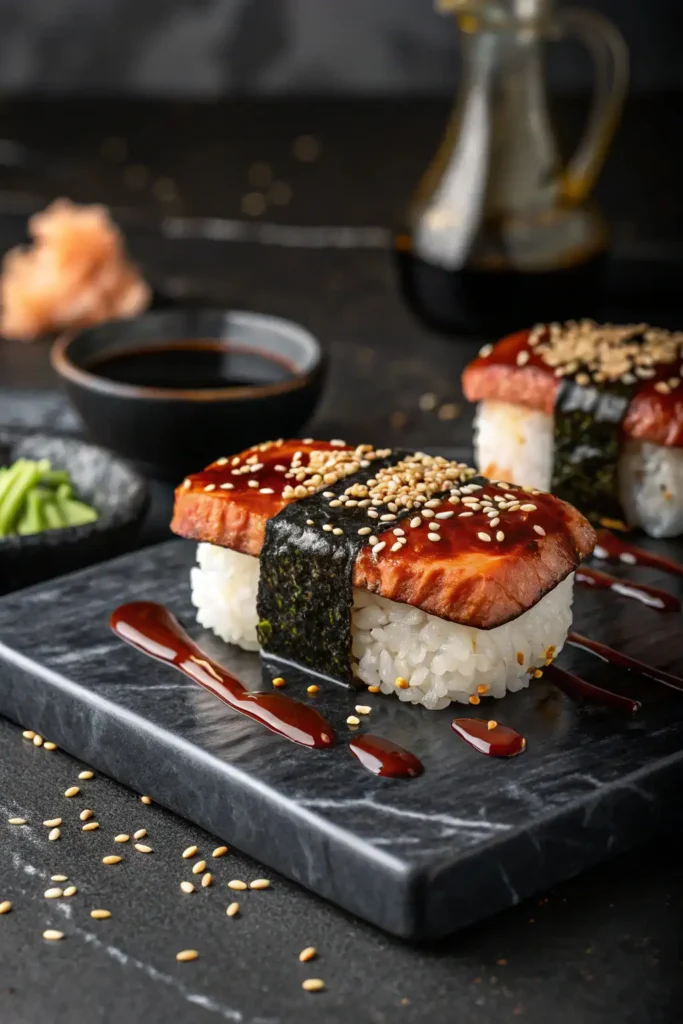
Drizzling a bit of sesame oil can also enhance the taste, giving it a rich aroma. I’ve even tried using different sauces like teriyaki or a soy sauce mix for a sweet twist. Each of these variations creates a new experience with each bite. Serve Salmon Sushi Bake as a hearty side dish or main course alongside your Spam Musubi.
Presentation and Storage
When serving Spam musubi, presentation matters. I wrap each piece in a strip of Japanese seaweed to keep it intact and visually appealing. Cutting the musubi into bite-sized pieces allows for easy handling and sharing.
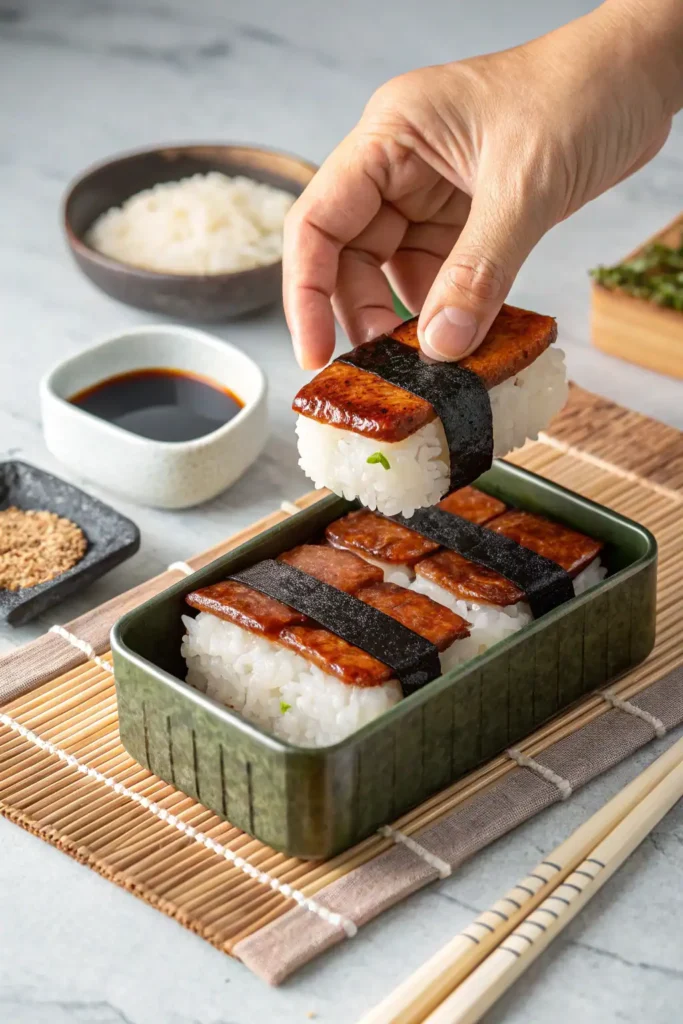
For storage, I find that wrapping each musubi in plastic wrap keeps them fresh. I store them in the refrigerator for up to three days. If I want to keep some longer, I freeze them. When ready to eat, I just thaw them in the fridge overnight and enjoy.
Using these tips, I ensure that my Spam musubi not only tastes great but also looks inviting. Finish your meal on a sweet note with Tanghulu—a delightful candied fruit snack.
Save This Recipe for How to Make Spam Musubi!
To make Spam musubi, it’s helpful to have the right details to hand. Here’s the breakdown of my recipe.
How to Make Spam Musubi
Course: Snacks, Rice-NoodlesCuisine: Hawaiian Snack4
servings10
minutes15
minutes25
minutesLearn how to make Spam musubi, the popular Hawaiian snack featuring rice, nori seaweed, and a sweet-savory glazed Spam topping.
Equipment
Rice cooker or pot
Frying pan
Nori (seaweed) sheets
Sushi mat (optional)
Sharp knife
- Ingredients
1 can Spam
2 cups cooked white rice
2 tablespoons soy sauce
1 tablespoon brown sugar
1 sheet nori, cut into strips
Furikake (optional for added flavor)
Directions
- Prepare the rice: Cook the rice according to package instructions.
- Cook the Spam: Slice the Spam and fry it until golden. Add soy sauce and sugar to glaze.
- Assemble: Place rice in the nori, add Spam, and roll tightly.
- Slice: Cut the musubi into pieces and enjoy.
Notes
- This recipe is easy to follow and can be customized to taste!
Spam Musubi: Frequently Asked Questions
I often get questions about Spam musubi, from making the sauce to using special tools. Here are some common inquiries and their answers.






